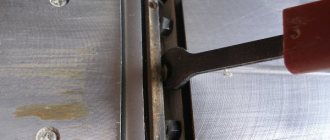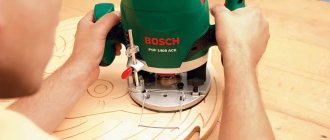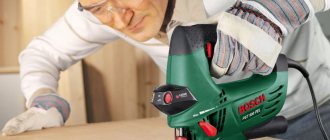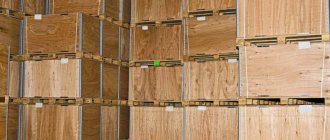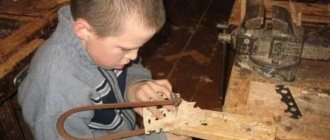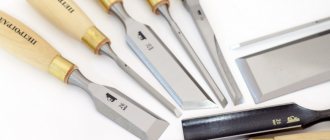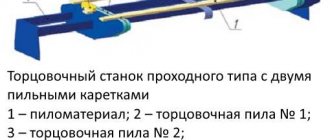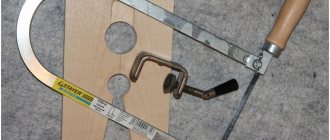From the author: hello, friends! Nowadays, carpentry can be not only a profession, a way of making a living, not only one of the men's jobs around the house or dacha, but also a hobby. Working with wood is a great opportunity to relieve tension and reduce stress. The monotonous process is calming, the smell of freshly cut chips can be inhaled with pleasure, and the beautiful result is pleasing to the eye.
In this article we will talk about how to choose a hand plane. Let's look at what types of equipment there are (and they are divided into two large groups: mechanical and electrical), what to look for when purchasing. We’ll also talk about how to avoid common mistakes when working with a plane. Let's start by getting to know this tool.
Design Features
To know how to choose a good hand plane, you should have an understanding of its design. Such instruments consist of the following main parts:
- Frame. This structural element is most often made of wood. It is in it that all the main components of the plane are attached.
- Knife. Sharpened at a certain angle.
- Clamp. Can be made from different materials. This can be a metal plate or bar.
- Chip breaker. Installed slightly higher than the knife. As you can already judge from the name of this element, it serves to break chips and guide them.
- Adjustment screw. This structural element is responsible for changing the position of the knife relative to the surface being processed.
All universal hand planes for wood have this design. The basic elements described above are also present in other, specialized varieties. On the body of any plane, among other things, there are two handles.
The best wooden planes
Wooden planes are simple and inexpensive. They consist of a sole, body, handle and knife. There can be two or one cutting elements. This tool is light in weight and does not overload your hands. Used in home workshops and woodworking hobby.
Wooden plane 240x60 mm Russia - for a beginner craftsman
This is the simplest instrument, called “school” because of its shape. This wooden plane is the best for a beginner and even a child who is starting to get interested in making wooden furniture. Small dimensions of 240x60 mm are convenient for users of any age and are suitable for processing both long boards and short bars.
Pros:
- cost from 300 rubles;
- cutout on the second handle for better support;
- the ability to adjust the depth of penetration of the knife to any level thanks to the wedge-shaped fixation;
- the cutting element made of 65G spring steel is less likely to become dull and fits well into wood of any hardness;
- weight 640 g allows you to work even in a vertical position;
- The body is varnished to prevent moisture absorption.
Minuses:
- angular body, which makes it uncomfortable to press on the instrument;
- the knife needs to be reheated additionally;
- There may be unevenness in the installation, which requires more precise fixation of the blade and wedge;
- sometimes the hardwood hull breaks;
- not suitable for wood with knots.
PINIE PremiuPlus 3-48 - for a real hobby
If someone is truly passionate about making wooden objects, then they will spare no expense in purchasing the best wooden plane from the Czech company Pinie. This model has a sleek design with a curved second handle for optimal grip. The back of the case is also curved and does not put pressure on the palm during operation. The knife width of 48 mm is optimal for processing timber, boards and slats.
Pros:
- the position of the knife at an angle of 45 degrees is best for smooth entry into the tree and productivity (in one pass you can remove up to 3 mm of wood in depth);
- well-polished sole ensures smooth gliding;
- a knife made of alloy steel will not quickly become dull;
- quick adjustment of blade depth;
- weight 890 g;
- the design includes a chipbreaker;
- The 220 mm long sole is practical on short workpieces.
Minuses:
- cost from 4500 rubles;
- Over time, the sole will wear out or may swell and become deformed if the tool is left on damp wood.
What to look for when choosing
The main element of the planer design is the knife. It is its quality that you should pay attention to first. This element must be made of high quality steel. In this case, the plane can be used for as long as possible without the need for sharpening. Of course, it is visually difficult to determine how well the material was chosen for the plane knife. Therefore, first of all, you should pay attention to the reputation of the manufacturer.
Of course, the cutting tool should never wobble. When purchasing, you should also check the front handle. It must also hold tight. In addition, when choosing a plane, you should pay attention to the size of the handle for the right hand. The length of this element varies. A tool with a small handle may simply not be suitable for a person with large hands.
Tools
0 votes
+
Vote for!
—
Vote against!
If you have ever been lucky enough to “finish” unplaned wood, then you know how labor-intensive and tedious this task is, especially if you use an old hand plane. Armed with such a tool and putting in a lot of effort, you can level the surface of wooden products, reduce their thickness and create a whole variety of extended recesses. High productivity, excellent results and significant savings in labor costs will be provided by an electric plane - an indispensable tool for carpentry work.
Content:
- Hand plane: main purpose and principle of operation
- Choosing an electric planer: what to look for
- Choosing what you need: review of the world's leading brands
- Some tips for beginners
Hand plane: main purpose and principle of operation
Unlike its mechanical counterpart, an electric plane is much more functional and convenient to use. Which is not surprising, since most of the load falls on the electric motor, and all you have to do is easily guide the plane in the desired direction.
The basic list of operations performed by an electric planer includes: preliminary planing, careful processing to size, fitting, beveling the edge, cutting out quarters. And the use of cutting tools and additional accessories significantly increases the functionality of the tool.
Of course, at first you may end up with sloppy “steps” that are very difficult to level. So pick out a few unwanted boards and learn how to plan. In addition, it is enough to install the electric plane motionlessly, and instead of a hand tool you will receive a reliable planing machine.
Like any other power tool, all models of electric planes can be classified into household and professional, differing only in the set of functions, power and permissible duration of continuous operation.
The main elements of a manual electric plane:
Therefore, we will not focus on the classification of electric planes, but will focus on those main points that will allow us to answer the question “how to choose a hand plane.”
So, the fundamental part of any electric planer is a rotating drum on which the knives are securely fastened. In order for the processed surface of the wood, which by its nature is heterogeneous, to turn out smooth, the electric motor rotating the drum must have sufficient power - from 580 to 900 W, as well as a rotation speed reaching 1000 rpm.
By means of a toothed drive belt, the rotational motion is transmitted from the electric motor to the drum, and since it periodically wears out and requires replacement, it is placed under a removable side casing. The second removable cover, located above the motor, hides the carbon electric brushes. Thanks to the smooth increase in motor rotation speed when turning on the tool and automatically maintaining it at a given level, the possibility of overloading the electric motor is almost completely eliminated.
The soleplate of the electric planer, made of high-quality aluminum, is divided into two parts: one part is located in front of the drum, the second is located at the back.
Being stationary, the rear part of the tool sole slides over the processed wood, while the front part still moves over an uneven surface and is adjustable in height, setting the required cutting depth and chip thickness. This adjustment is made using a handle or a button with divisions, which often acts as a second handle. When working with an electric planer, you should move it at a constant speed, which is determined by the thickness of the chips being removed.
Some models are equipped with a drum that is accessible from one side. This allows you to select a quarter at a 90 degree angle along the entire length of the board. Using the side stop, which is often included with the tool, you can, without much effort, select a quarter of the width you need.
In addition, such models are additionally equipped with a protective folding cover, which is located on the side of the drum during the classic operation of an electric planer and rises to the upper plane at the moment when you select a quarter.
More details about the design features of electric planes in the YouTube video.
Choosing an electric planer: what to look for
When choosing a suitable electric planer model, you need to pay attention to certain points.
Sole
The sole of the plane largely determines the final result of the processed wood surface: a smooth sole guarantees a perfectly even planed wood.
The air cushion formed during the work process usually creates obstacles to obtaining a cut of the same thickness. However, this problem is completely solvable; you just need to use a sole with grooves. Several grooves located on the front section of the sole are V-shaped and are designed to eliminate chamfers from the corners of the processed products.
Adjusting the height of the front section of the sole of the electric planer involves moving it in the vertical and diagonal directions. In this case, the sole of the tool is always equidistant relative to the knives, which ensures a thin, even cut. It should be noted that the length and thickness of the sole of the electric planer determines its stability during operation.
Electric planer handles
It is always easier to move such a heavy tool as an electric planer across the surface being processed using two handles rather than one.
Using the rear handle, you can push the tool, while the front handle allows you to adjust the direction of movement of the electric planer and provides the opportunity to work “in a big way.” It is enough to press hard on the front handle, and the chips removed will be thicker.
Possibility of adjusting the thickness of the removed chips
Since the adjustment knob on a power tool sometimes acts as a second handle, it can be seen with internal notches that protect against accidental or unwanted switching of the set chip thickness.
Typically, the switching step is 0.1 mm, but each tool model may have its own characteristics: for example, some models of electric planes continue to remove chips. It is preferable to choose those models whose scale starts from “0”, for example, a tool from MAKITA.
Electric planer knives
All models of electric planers are equipped with two removable removable knives made of tungsten and carbide. However, there are manufacturers offering knives made of hardened steel, sharpened using a holder, which will provide the required sharpening angle.
Thanks to the centering groove, straight carbide knives easily fit into place in the knife holders located in the grooves of the drum. But hardened steel knives require more careful alignment relative to each other.
Knife protection
All models of electric planers are equipped with two types of protective devices, interconnected and located on the side and bottom. They completely eliminate contact of fingers and the surface being processed with the knives of the equipment. A protective plate on the side of the power planer allows you to cover the edge of the drum and rises as far as the power tool goes deeper into the wood being processed when selecting a quarter.
Chip ejection
Thanks to the direct ejection of chips, the tool is reliably protected from clogging, but they can scatter throughout the room. The direction of the ejection mouth will make cleaning much easier.
Depth gauge and side stop
Using the side stop and depth gauge in the electric planer, which must be included in the tool, you can set the exact depth and width of the chips to be removed.
In order to cut corners, some stops must be tilted 45˚. The side stop is essential for creating fine edges: it gives the power tool balance
Accessories for electric planer
An electric hand planer can be equipped with various accessories, for example, wavy knives made of hardened steel, which are effective for rough processing of wood. By equipping an electric planer with equipment for a fixed installation, you will turn it into a planer and an automatic jointer at the same time. Of course, this is very convenient, but it requires special attention to ensure safe operation of the equipment.
Ergonomics of an electric planer
The large dimensions and heavy weight of the electric planer give good balance, but can become a hindrance when processing a large volume of wood and when working in a big way.
Choosing what you need: review of the world's leading brands
Today, the construction tools market represents a huge range of household and professional hand planes, the price of which depends on the functional load and configuration, appearance and technical characteristics. Let's look at products from leading brands, including Skil, Metabo, Makita, Bosch, Black&Decker, DeWalt and Atlas Copco
Electric planer Skil
The Skil hand metal planer is equipped with ultra-sharp knives and a durable knife drum with electronic balancing. From the Skil line of electrical equipment, models 1506V and 1510V stand out, which differ in power: 1506V consumes 450 W, while the planing depth and width reaches 0.6 mm and 82 mm, respectively. The consumption of the 1510V model is 500W, but the planing depth increases to 1.0 mm.
Metabo electric planers
In the Metabo product line, the title of favorite deservedly belongs to the HO 0882 model. And all because its power of 800 W does not overload the network of a private home or country house. In one pass, the planing depth will be 3.0 mm. The compact tool features a comfortable handle with push-button start and a durable front handle with depth adjustment.
The drum rotates at a speed of 12,000 rpm, which allows you to do the same amount of work in a minute that you would do after 24,000 strokes with a regular hand plane. The model is equipped with a set of additional knives for decorative wood processing.
Makita electric planers
A powerful and reliable Makita plane can satisfy all the needs of the most demanding users. If you require fine finishing and adjustment of the thickness of the cut as you work, then you cannot do without an electric planer model 1902 or 1923H. The rotation speed reaches 16,000 rpm, the planing depth is 1.6 mm, while the power is 750 W and 850 W, respectively.
Bosch electric planers
Bosch electric planers are the perfect combination of price and quality. Among household models, a special place is occupied by electric planers PHO 25-82 and PHO 16-82, which differ from each other in terms of power consumption - 750 W and 500 W, respectively. The practically silent model PHO 16-82 is equipped not with two knives, but with one, due to which the number of revolutions per minute reaches 18,000, and the planing depth is 1.6 mm.
Among the professional products, we can highlight the GHO 31-82 and GHO 36-82C models with an increased planing depth of 3.6 mm and a power consumption of 750 W and 850 W, respectively.
Electric planers Black&Decker
Powerful and high-precision household electric planers Black & Decker are equipped with excellent carbide double-sided knives and are equipped with a chip removal device. The most preferred model is KW715 with a power consumption of 550 W and a planing depth of 1.6 mm. The drum rotates at a speed of 15,000 rpm. The KW725E electric planer is slightly more powerful than the previous model: the power is 900 W, and the planing depth is 2.5 mm. Modern control electronics make it possible to precisely regulate the rotation speed.
Professional electric planers from DeWalt are equipped with a front handle, which also allows you to adjust the depth of planing. A powerful motor increases the service life of the tool, and the support block protects the surface being processed from possible damage. Modern electronics allow you to maintain a constant speed under load, and a unique spiral knife will provide better wood processing.
Some tips for beginners
1. When finishing untreated, rough wood, first set the plane to the maximum cutting depth, and only on the next pass significantly reduce it. While working, do not put too much pressure on the tool, because the edge of the wood being processed is rounded.
2. Armed with an electric or manual plane, always plan in the direction of the wood grain. If the surface to be treated consists of several bars or boards, then it is recommended to plan at an angle to the adhesive seams and in the direction of the fibers. Since the sharp edges of wood will splinter over time, it is better to provide a chamfer. The sole of most modern models of electric planers has a triangular groove, which makes chamfering easier.
3. Often, even the most thorough treatment of the wood surface with an electric planer requires the elimination of barely noticeable marks using a hand scraper, the edge of which must be sharp and even. By moving it at a slight angle in the direction of the grain, you will cut off excess protrusions and level the surface. Finally, sand the surface - this will give it a particularly smooth finish.
4. If your tool gets stuck or produces shaggy chips, sharpen the cutter. To do this, use a sharpening machine with clamps that will allow you to fix the desired angle of inclination - usually 25°. This angle is suitable for a blade thickness of 6.7-7mm. Sharpen evenly, otherwise you will significantly complicate further work with the electric planer.
5. You can use a soft pottery wheel to sharpen the cutter. Make sure that the metal does not burn or overheat; to do this, lightly touch the sharpening wheel with the blade, cooling it from time to time. The sharpening wheel must rotate constantly against the blade. If burrs occur during sharpening, remove them by fine sanding using Belgian stone, wheel oil, or leather sanding belts. Sand until you are sure the edge of the blade is completely smooth.
6. And finally, remember that an electric planer is considered a very dangerous tool, even despite the fact that all the cutting elements are hidden, so be very careful and careful. Good luck!
Varieties
Of course, you should choose a hand plane based on the specific purposes for which it will be intended. There are several types of planes on sale today. The most popular are:
- Universal. This is a regular plane that can be used to do most carpentry work.
- Jointer. The body of this instrument is longer than that of a conventional one. A jointer is used to process large workpieces.
- End plane. The knife of such a tool is located at a flatter angle. This allows high-quality processing of end grain fibers.
- Zenzubel. A plane of this type is used mainly for making various kinds of carpentry joints and folds.
The best inexpensive electric planers
And among the budget instruments there are interesting models. In most cases, these are high-quality planes with reduced functionality, intended for the simplest jobs.
Interskol R-82/650 – durable model
4.8
★★★★★
editorial assessment
87%
buyers recommend this product
See review▶
The domestic plane received an engine with a good power reserve - this is enough to solve most household problems.
The functionality of the model is limited to the ability to remove quarters (up to 15 mm) and three grooves for chamfering. However, buyers note the decent quality of the complete knives, as well as a smooth and clean cut.
The ejection of sawdust during operation is organized in both directions. The only thing to remember is that out of the box the model will require tightening the knives and adjusting the movable support platform.
Advantages:
- Reliable engine;
- Cast supports;
- Properly organized chip ejection;
- The price is only 2600 rubles.
Flaws:
- Short and rigid power cable (2 m);
- Inconvenient handle.
Interskol R-82 is suitable for simple repair and construction work that does not require many functions from the tool, but is capable of “working” for a long time without overheating.
READ ALSO
14 best wall chasers
Whirlwind R-82/1100 – a powerful tool without unnecessary bells and whistles
4.6
★★★★★
editorial assessment
83%
buyers recommend this product
This new product in the line of the domestic manufacturer copes well with any task thanks to its powerful power plant and high cutting drum speeds. The well-implemented security system is also impressive, which is uncharacteristic for a budget category tool.
The reliability of the planer ensures a decrease in the starting current and protection against motor overload. But the functionality of the tool is limited to selecting a quarter and adjusting the processing depth. However, at a price of 3,100 rubles, you shouldn’t expect more.
Advantages:
- Good power reserve;
- High-quality assembly;
- Light weight;
- High level of security;
- Parallel stop.
Flaws:
- There are no grooves for chamfering;
- Not suitable for long-term use.
Although the functionality of this model is seriously reduced, I am glad that the manufacturer did not skimp on the quality and safety of the tool.
READ ALSO
6 Best Surface Grinders
Bort BFB-850-T – functional and inexpensive
4.5
★★★★★
editorial assessment
87%
buyers recommend this product
See review▶
A compact, lightweight tool for short, small jobs turned out to be the most balanced in terms of such indicators as power, drum speed and functionality. With its help, you can cleanly plan dry wood, select a quarter, and chamfer.
For convenience, the manufacturer has provided a parallel stop, a bag for collecting sawdust and additional carbon brushes in the kit. The sawdust ejection direction of the Bort BFB is organized in both directions.
Advantages:
- Compact dimensions;
- Reliability;
- Easy to use;
- Decent equipment.
Flaws:
- When operating for a long time, the gearbox becomes noticeably hot;
- The numbers on the depth adjustment scale are hard to see.
In general, Bort BFB is good for beginners who have not yet decided on their requirements for the tool.
READ ALSO
9 best slotting machines
Reviews of plane brands
Carpentry tools of this type are sold on the modern market from different manufacturers. Many brands are of very good quality. For example, planes from companies such as Bailey and Handyman have earned good reviews from craftsmen. Bailey tools are valued primarily for the excellent quality of their knives and long service life. Sharpening the knife of a hand plane of this brand is done quite rarely. Sometimes there are comments that mention the build quality is not very good. But even if any shortcomings are found in the purchased tool, they can usually be easily and quickly eliminated, and on your own. Handyman planes, judging by the reviews, are also convenient and reliable. Their only drawback is their not very neat design.
Experienced craftsmen do not advise purchasing Groz brand products (India). Despite the fact that the products of this brand are classified as expensive, judging by the reviews, they are not of particularly good quality. Their build quality is simply disgusting, and at the same time it is inconvenient to work with them.
Types of planes for figure cutting
Models that allow the execution of complex geometric elements are considered a separate category of tools for wood.
Externally, such devices are no different from the classic planer model, but they have their own distinctive characteristics.
They are divided into:
Zenzubel
The tool consists of 2 knives, thanks to which good results are achieved on a wooden base. It is considered effective in the process of planing perpendicular and horizontal surfaces. The cutter of the device has a width of 30 mm. Outwardly it looks like a scraper;
Federgubel
It is used for cutting longitudinal elements on the surface of workpieces. The design of the tool uses an unusual shape of the cutting part, thanks to which it is possible to carry out grooving;
Falsebel
It is considered one of the best models of devices. It is used for cleaning small items. The planer design includes oblique and straight knives. The sole of the product is made in the form of a multi-stage element. As a result, it is possible to correctly select the folds that will correspond to the required profile;
Staffgobel
The tool model has a rounded blade, thanks to which it is possible to perform fast, effective processing on the surface of concave parts;
tongue and groove
The product consists of two pads. They are connected to each other with large screws. It is used to create a longitudinal groove on the surface of the edge. One element of the tool is used for the guide, and the second has two cutters. Thanks to the cutting parts, it is possible to create concave elements;
Mold
This type of plane is considered the main one for creating curly patterns on the surface of wood. The tools are used to create wooden cornices and complex baguettes. The device is equipped with several cutters. They have a figured shape, thanks to which decorations are obtained.
How to use
Hand planes for wood are simple in design and quite easy to use. The main thing is to do the work smoothly, without jerking. This is especially true for very long workpieces. If this condition is met, the surface of the finished product will be very neat and smooth. When planing, you should stand to the side of the workpiece, with one foot forward.
The top and bottom surfaces of the products are very easy to process. It is somewhat more difficult to do work on the edges. In this case, it is important to secure the knife very firmly. Under no circumstances should it vibrate in the block. Edges should be planed exclusively in the direction of the grain.
There is also a technique that allows high-quality processing of very wide workpieces. In this case, the product is first planed diagonally, adhering to the direction of the fibers. Next, the plane is checked for evenness using a special ruler. At the final stage, finishing is carried out. In this case, a thin layer of chips is removed from the workpiece parallel to the edge.
The best metal planes
Such a tool is more durable than its wooden counterparts, and can contain additional adjustments for the reach and location of the knives. It is used in everyday life and small workshops. Screw mechanisms require lubrication.
BAILEY SMOOTHING PLANE Stanley No. 4 - simplicity and durability
This is the best metal plane for occasional use as it has a cast iron body for durability. The main handle is ergonomic and completely follows the curves of the palm grip. The weight of 2 kg does not require strong additional pressure to insert the knives into the wood.
Pros:
- it is easy to change the position of the knife with high precision (a folding lock for quickly changing the depth and transverse position, as well as an adjustment wheel for final adjustment);
- body made of gray cast iron;
- varnished decorative coating;
- handles made of durable polystyrene are resistant to cracks when dropped;
- the chipbreaker prevents wood from splitting;
- it is possible to plan edges with bevels due to the curved installation of the blade;
- The blade width of 50 mm facilitates rapid passage of large areas.
Minuses:
- cost from 3800 rubles;
- the pin fixing the rear handle does not tighten it tightly, which needs to be improved by boring the inlet hole;
- For professional use, the sole needs to be polished using a lapping stone.
How to sharpen a knife
Of course, a hand plane, like any other tool, requires some care. No matter how good the steel the knife of this tool is made of, sooner or later it will still become dull and will have to be sharpened. Most often, this procedure is performed on a special stone called a touchstone. The latter is pre-wetted with water. When sharpening, it is advisable to moisten the knife itself. You should press it against the stone as tightly as possible.
The sharpening angle of a hand plane may vary depending on the model. Most often this figure is 30 degrees. When working on a whetstone, you usually just pay attention to how the blade was originally sharpened.
Sometimes experienced carpenters sharpen a plane knife on a wheel. In this case, it should be pressed not against the edge, but against the side surface. When using a wheel, you can also get a pretty high-quality sharpening. It will be very convenient to use a hand plane with such a knife. But only if you use an abrasive fine-grained abrasive wheel. After sharpening on such a tool, finishing is usually done. This procedure is performed either on a piece of sandpaper mounted on a table or on a block. Checking the quality of sharpening is quite easy. To do this, you just need to carefully examine the blade. If it does not shine, then the knife is sharp enough to be used.
Choosing between professional and household electric planer
Modern technologies are increasingly replacing manual labor. This is what happens in carpentry too. Today, power tools are used for large volumes of work. The same applies to the plane. On the market you can find many types and brands of similar electric tools.
The main working element of an electric planer is a drum with knives mounted on it. The latter can be from one to four pieces. The drum rotates and the knives process the surface. The higher the speed of such rotation, the faster and better the work will be done. For most household electric planers, this figure is 10-15 thousand revolutions per minute.
When choosing such a tool, first of all you should pay attention to its purpose. Here, manufacturers offer two options - a household and a professional electric planer. In addition to their cost, these tools differ in other important characteristics.
Firstly : this is their power. If the household version has from 600 to 1000 W, then for the professional one the minimum value is 1.2 kW.
Very often, manufacturers indicate two values for this parameter in the instrument documentation. The first, largest, indicates maximum power. It is to this concept that the values of 600-1000 W are tied - for household tools. The second value represents the effective power. When choosing, you should pay attention to this parameter; it should be more than 350W.
The effective power of the electric planer must be at least 350W
Secondly: a professional electric planer has more adjustment options. For example, the planing depth of a household tool can be set from 0 to 2.5 millimeters. If you take a professional plane, then this value can be increased to 4 mm. Also, pay attention to the adjustment step. The lower this value, the better the quality of the material can be processed.
A professional plane is more powerful, which means that its weight is significantly greater than the household version. In the first case, we are talking about a minimum of 4 kilograms. Sometimes the weight of a professional electric planer reaches 9 kg. For the household version this value is less. The weight of the simplest plane is 2.5 kg, and a more powerful one can reach up to 4.
In addition, a professional tool can have many different additions. For example, many electric planers are equipped with an electronic system for maintaining a certain, predetermined number of revolutions. The household version of the tool does not have such an addition.
When choosing between a professional and a household tool, you should clearly know what you will use it for. If you need a plane not so often, to perform simple tasks, then there is no point in purchasing expensive equipment. But if you practice professionally, then the instrument must match.
How to set up a hand plane correctly
To perform this procedure you will need a special screwdriver. Such tools are designed specifically for setting planes. Their distinctive feature is their large width and short length. The main purpose of setting up a plane is to set the amount of blade protrusion above the surface of the sole. If the knife protrudes too far, the plane will begin to remove very thick chips. A slightly exposed blade will simply slide across the surface of the wood.
For initial processing of workpieces, the knife yield should be about 0.5 mm. If the plane is to be used for finishing, the blade should protrude slightly less over the sole.
How to store it correctly
Experienced craftsmen believe that a knife for a hand plane becomes dull, for the most part, not even during operation, but because of improper storage. After finishing planing the workpieces, this tool should be cleaned of chips and placed in a box specially designed for it. In this case, the position of the tool should be such that the knife blade protruding from the body is not at the bottom, but at the side.
If the hand plane is going to be stored for a very long time, it must be disassembled and thoroughly cleaned before putting it in the box. Knives and other metal parts should be wiped with an oiled rag.
Which electric planer is better to buy?
Buying tools is always a responsible matter. Especially when it comes to electric models. Their performance is superior to manual ones, but safety requirements must be special. The power and other technical characteristics of a future purchase must be correlated with the work to be performed. Therefore, even in the recommended list you need to find your suitable model; some recommendations will help with this:
- The Makita KP0800 electric planer is ideal for even hard wood;
- For its advantages, the Black+Decker KW712 model has a very budget price;
- Diold RE-1500-01 will work reliably in any weather conditions;
- Rebir IE-5708M processes 15.5 centimeters of surface in one motion;
- All products after BOSCH GHO 26-82 D Professional look like factory ones;
- Mafell MHU82 T-MAX set is guaranteed German quality for professional work;
- The Makita KP312S will be safe even when connected to ungrounded outlets.
Buying the best electric planers is quite affordable. It's not always about high cost. Sometimes the extensive capabilities of expensive models are simply not needed. There are also quite budget tools with excellent characteristics.
